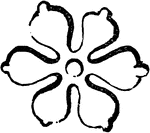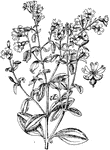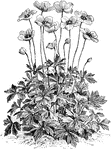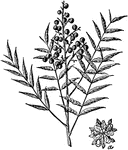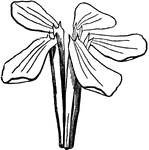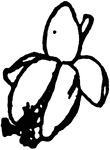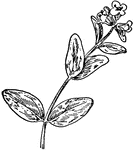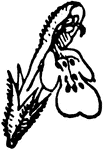
Sedum
Sedum is the large stonecrop genus of the Crassulaceae, representing about 400 species of leaf succulents,…

Selago
"Selago distans. 1. a flower; 2. an anther; 3. a perpendicular section of an ovary; 4. section of seed…

Self-Heal
"Self-heal. (Prunella vulgaris). The upper part of the stem with flowers. a, the calyx; b, the corolla;…

Semi-Formal Garden Space
Pictured is a semi-formal garden space of annual flowers. Annuals are plants that bloom in the open…
Disk-floret of the Senecio
An illustration of a disk-floret of the senecio flower. Senecio is a genus of the daisy family (Asteraceae)…

Disk-floret of the Senecio (Longitudinal Section)
An longitudinal section view of a disk-floret of the senecio flower. Senecio is a genus of the daisy…

Female ray-floret of the Senecio
An illustration of a ray-floret of the senecio flower. Senecio is a genus of the daisy family (Asteraceae)…
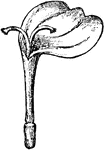
Gynaeceum of the Senecio
An illustration of the gynaeceum of the senecio flower. Senecio is a genus of the daisy family (Asteraceae)…
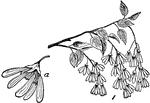
Canadian Serviceberry
A branch of the Canadian Serviceberry (Amelanchier canadensis), a shrub or small tree, showing flowers.

Sesame
The Sesame (Sesamum orientale, Sesamum indicum) is a flowering plant in the Pedaliaceae family of pedaliums…

Silene Pennsylvanica
Longitudinal section of flower of Silene Pennsylvanica, showing stipe between calyx and corolla.
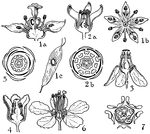
Orders of Simarubaceae, Burseraceae, Meliaceae, and Malpighiaceae
The orders of simarubaceae, burseraceae, meliaceae, and malpighiaceae are pictured. The flowers of these…
Simple Pistil
Model of a simple pistil, with ovary cut across and slightly opened ventrally, to show the ovules and…

Single Fruit
Composite, or compound flower, from one of the largest botanical orders. 4, single fruit.
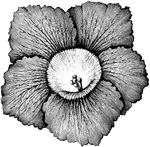
Flower of Single Garden Petunia
In the single varieties of petunia there is variety in coloring. Some are beautifully veined, striped,…
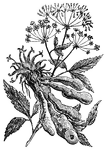
Skirret
Sium sisarum. "A species of water parsnip, generally said to be of Chinese origin, long cultivated in…
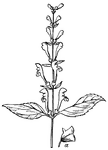
Skullcap - Upper Part of the Flowering Stem
"A plant of the genus Scutellaria: so called from the helmet-like appendage to the upper lip of the…
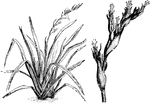
Small Flax Lily
Small flax lily is the common name of phormium cookianum. The flowers are yellow with greenish outer…
![Smilax is a genus of about 300-350 species, found in the tropics and subtropics worldwide. In China for example about 80 are found (39 of which are endemic), while there are 20 in North America north of Mexico[1]. They are climbing flowering plants, many of which are woody and/or thorny, in the monocotyledon family Smilacaceae, native throughout the tropical and warm temperate regions of the world. Common names include catbriers, greenbriers, prickly-ivys and smilaxes. "Sarsaparilla" (also zarzaparrilla, sarsparilla) is a name used specifically for the Jamaican S. regelii as well as a catch-all term in particular for American species. Occasionally, the non-woody species such as the Smooth Herbaceous Greenbrier (S. herbacea) are separated as genus Nemexia; they are commonly known by the rather ambiguous name "carrion flowers"](https://etc.usf.edu/clipart/57000/57029/57029_smilax_mth.gif)
Smilax
Smilax is a genus of about 300-350 species, found in the tropics and subtropics worldwide. In China…
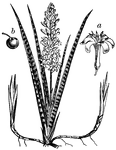
Snake Plant
Sansevieria Zeylanica is the Latin name, but this plant is also called a Mother-in-law's Tongue. "A…

Maryland Black Snakeroot
Of the Parsley family (Umbelliferae), the Maryland black snakeroot (Sanicula marilandica).

Seneca Snakeroot - Roots and Base of the Stem
"Polygala senega of eastern North America. It sends up several stems from hard knotty root-stocks, bearing…
Seneca Snakeroot - Stem and Flowers
"Polygala senega of eastern North America. It sends up several stems from hard knotty root-stocks, bearing…

Seneca Snakeroot - the Fruit
"Polygala senega of eastern North America. It sends up several stems from hard knotty root-stocks, bearing…

Snapdragon
"2. corolla of Antirrhinum majus cut open; 3. its pistil; 4. its ripe fruit; 5. cross section of its…
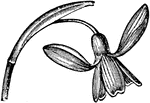
Snowdrop
Snowdrop is the common name for members of the genus Galanthus, a small genus of about 20 species in…

Soapberry
"Sapindus senegalensis. 1. an expanded flower; 2. a petal; 3. the ovaries before fertilisation; 4. a…
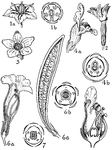
Orders of Solanaceae, Scrophylariaceae, Bignoniaceae, and Pedaliaceae.
Pictured are flowers of the orders solanaceae, scrophulariaceae, bignoiaceae, and pedaliaceae. The flowers…
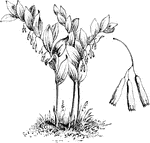
Solomon's Seal
Also known as Polygonatum multiflorum. Consists of several peduncles and white flowers. They are commonly…

Sorrel
"The common sorrel is a meadow plant, slender in habit, with halberd-shaped, juicy, acid flavored leaves,…

Branch of Spanish Bayonet
Also known as Yucca schidigera. A flowering plant that is native to the Mojave Desert in the Western…

Branch of Spanish Dagger
Also known as Yucca gloriosa. The branch of a Spanish Dagger plant, part of the agave family.

Spearmint Flower
"An aromatic plant, Mentha viridis, the common garden-mint, or mint proper. It is known chiefly in gardens,…
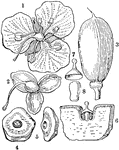
Spiderwort
"Aneilema crispatum; 1. a flower; 2. the calyx and pistil; 3. the capsule; 4, 5, seeds; 6. a section…

Spindle Tree
"The common spindle tree (Euonymus europaeus) is a European shrub, which bears glossy lanceolate…

Canadian St. John's Wort
"Canadian St.-John's-wort (Hypericum Canadense). a, leaf; b, seed-capsule." -Whitney, 1911

Marsh St. John's Wort
"Marsh St.-John's-wort (Triadenum Virginicum). a, flower; b, seed-capsule." -Whitney, 1911

Flower Stem of St. Joseph's Lily
St. Joseph's Lilies are pure pearl white. The flowers are two to three inches long. The flowers bloom…






